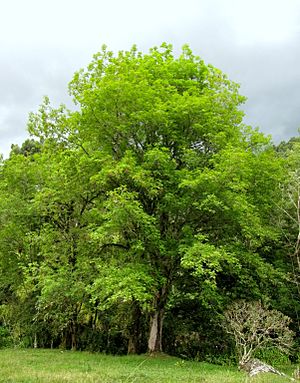Tropical ash facts for kids
Quick facts for kids Tropical ash |
|
|---|---|
 |
|
| Conservation status | |
| Scientific classification | |
| Genus: |
Fraxinus
|
| Species: |
uhdei
|
| Synonyms | |
|
|
The Fraxinus uhdei, also known as tropical ash or Shamel ash, is a type of tree. It grows naturally in Mexico and Central America. People often plant it along streets in Mexico and the southwestern United States.
This tree has also been planted in Hawaii. There, it has spread from gardens and is now considered an invasive species. This means it can grow too much and harm local plants.
Like other trees in its group, Fraxinus uhdei is dioecious. This means that male and female flowers grow on different trees. One tree will have only male flowers, and another tree will have only female flowers.
About the Name
The tropical ash was first described in 1883. A scientist named Theodor Wenzig thought it was a type of Fraxinus americana. Then, in 1907, Alexander von Lingelsheim decided it was its own unique species.
The name uhdei honors Carl Uhde. He was a German plant collector. He explored Mexico in the 1840s and found many plants.
This tree has many local names. In Spanish, it is often called fresno blanco. In English, people also call it Hawaiian ash or Mexican ash. The name Shamel ash comes from Archie Shamel. He brought these trees to California in the 1920s. In Colombia, where it was brought in the 1950s, it is known as Urapan.
Tree Health
In 2004, some of these trees in Colombia and Ecuador started to get sick. They suffered from something called a phytoplasma. A phytoplasma is a tiny organism. It can cause a tree to get sick and parts of it to die, which is called "dieback."
See also
 In Spanish: Fraxinus uhdei para niños
In Spanish: Fraxinus uhdei para niños


